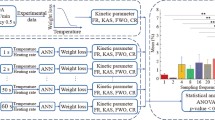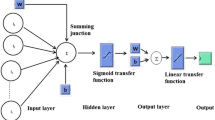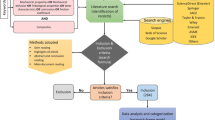Abstract
The aim of this study was to correlate the results of experimental data using DTA method and predictions of artificial neural network (ANN) and multivariate linear regression (MLR). Thermal decomposition of polymers was analyzed by simultaneous DTA method, and kinetic parameters (critical points, the change of enthalpy and entropy) of polymers were investigated. A computer model based on multilayer feed forwarding back propagation and multilayer linear regression model were used for the prediction of critical points, phase transitions of low-density polyethylene (LDPE) and mid-density polyethylene. As a result of our study, we concluded that ANN model is more suitable than MLR about prediction of experimental data.












Similar content being viewed by others
References
Sebastiao RCO, Braga JP, Yoshida MI. Competition between kinetic models in thermal decomposition analysis by artificial neural network. Thermochim Acta. 2004. doi:10.1016/j.tca.2003.09.009.
Tomaszewicz E, Kotfica M. Application of neural networks in analysis of thermal decomposition of CoSO 4. J Therm Anal Calorim. 2003. doi:10.1023/B:JTAN.0000005197.33066.f5.
Ayhan-Sarac B. Neural network methodology for heat transfer enhancement data. Int J Numer Methods Heat Fluid Flow. 2007. doi:10.1108/0961530710825774.
Ayhan T, Karlik B, Tandiroglu A. Flow geometry optimization of channels with baffels using neural networks and second-low of thermodynamics. Comput Mech. 2004. doi:10.1007/s00466-003-0509-1.
Browna ME, Maciejewskib M, Vyazovkinc S, Nomend R, Sempered J, Burnhame A, Opfermannf J, Streyg R, Andersong HL, Kemmlerg A, Keuleersh R, Janssensh J, Desseynh HO, Lii CR, Tangi TB, Roduitj B, Malekk J, Mitsuhashil T. Computational aspects of kinetic analysis part A: the ICTAC kinetics project-data, methods and results. Thermochim Acta. 2000. doi:10.1016/S0040-6031(00)00443-3.
Beken M. Developing differential thermal analysis device under high pressure. PhD Thesis, Yildiz Technical University; 2002.
Bundy FP. Effect of pressure on emf of thermocouples. J Appl Phys. 1960. doi:10.1063/1.1708993.
Michalik K, Drzazga Z, Michnik A, Kaszuba M. Differential scanning microcalorimetry study of thermal stability of nevirapine and azidothymidine mixture. J Therm Anal Calorim. 2006. doi:10.1007/s10973-005-7171-0.
Richter PW, Clarke JB. Asymmetrical friction in a piston-cylinder device and the effect on the melting curves of indium and bismuth. Rev Sci Instrum. 1980. doi:10.1063/1.1136354.
Sozen A, Arcaklioglu E, Ozalp M. A new approach to thermodynamic analysis of ejectorabsorption cycle: artificial neural networks. Appl Therm Eng. 2003. doi:10.1016/S1359-4311(03)00034-6.
Haykin S. Neural networks: A comprehensive foundation, 2–3. Englewood Cliffs: Macmillan College Publishing Company; 1994.
Caballero JA, Conesa JA, Font R, Marcilla A. Pyrolysis kinetics of almond shells and olive stones considering their organic fractions. J Anal Appl Pyrol. 1997. doi:10.1016/S0165-2370(97)00015-6.
Karlik B. Myoeletric control of multifunction prothesis using neural networks. PhD Thesis, Yildiz Technical University; 1994.
Maimon OZ, Rokach L. Data mining and knowledge discovery handbook. New York: Springer; 2005.
Brillinger DR. The identification of a particular nonlinear time series system. Biometrika. 1977. doi:10.1093/biomet/64.3.509.
Acknowledgements
The author wishes to thank Dr. Reha Basaran for the support of experimental studies and Ozlem Ilgun for neural network studies and Derya Kosucuoglu for the support of MLR studies. Also the author wishes to thank Emirhan Emre for his technical support.
Author information
Authors and Affiliations
Corresponding author
Rights and permissions
About this article
Cite this article
Beken, M. The neural network and multivariate linear regression approach for observing phase transitions of polymers with the differential thermal analysis method. J Therm Anal Calorim 101, 339–347 (2010). https://doi.org/10.1007/s10973-010-0749-1
Received:
Accepted:
Published:
Issue Date:
DOI: https://doi.org/10.1007/s10973-010-0749-1




